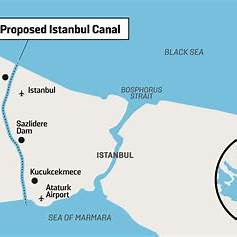“He who has Constantinople has the key to the house of the Lord.” Otto von Bismarck
For centuries, the Bosporus Strait has been more than just a narrow waterway—it has been a critical juncture where East meets West, a chokepoint that has shaped the economic and geopolitical fortunes of empires. From the Byzantine Empire to the Ottoman Empire, controlling this strategic passage meant controlling the flow of wealth, trade, and military power. Ancient cities like Constantinople flourished because of their commanding position along this vital waterway. Ships laden with grain, precious metals, and luxury goods from the East passed through the Bosporus, enriching these cities and making them powerful hubs in the global economy.
During the height of the Ottoman Empire, the Bosporus was the lifeline that connected the Black Sea to the Mediterranean, allowing the Ottomans to control key trade routes between Europe, Asia, and Africa. This allowed them to tax merchants and charge tolls for passage, creating an economic windfall that helped fund their vast empire. The strategic location of the Bosporus also gave the Ottomans control over naval access, cementing their dominance in the Mediterranean and Black Sea regions.
Today, the Black Sea basin is home to over 350 million people and supports nearly $500 billion in annual trade. The region is a critical conduit for global commerce, with major exports including:
Grain from Ukraine and Russia,
Energy from Azerbaijan, Romania, and Turkey,
And metals and machinery from Bulgaria and Turkey.
Turkey still holds the keys to this crucial gateway. However, as the world has evolved, so too has the geopolitical importance of this waterway. With global trade booming and the energy demands of the modern world reaching unprecedented levels, Turkey is now looking to assert greater control over its maritime future. Enter the Istanbul Canal, a $10 billion mega-project that aims to create an alternative route for shipping traffic—one that could reshape the region's economic and geopolitical dynamics for years to come. Expected to increase shipping capacity by 25%, reduce wait times by up to 36 hours per vessel, and accommodate larger LNG tankers and oil shipments, the canal will solidify Turkey’s role as a key player in regional energy flows and trade. But its significance extends far beyond logistics—it’s a geostrategic tool that will have profound implications for NATO, U.S. power projection, and the wider Eurasian energy landscape.
Launched in 2021, the Istanbul Canal is a 45-kilometer-long, 25-meter-deep artificial channel that connects the Black Sea to the Sea of Marmara. At a projected cost of ₺75 billion ($10 billion), the canal aims to handle over 160 vessel transits per day, alleviating pressure on the Bosporus, where over 40,000 vessels currently pass annually—four times more than the Panama Canal.
Aside from reducing accident risk and marine congestion, the canal provides Turkey with sovereign control over a parallel maritime route—one that sits adjacent to but “outside” the framework of the Montreux Convention, which governs the movement of naval ships through the Bosporus and Dardanelles straits.
Keep reading with a 7-day free trial
Subscribe to The Monetary Skeptic to keep reading this post and get 7 days of free access to the full post archives.




